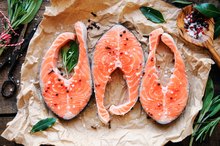What Is the RDA for Lipids?
Nuts, oils, avocado, meat, milk...a variety of foods contribute fats to your diet. One responsibility of the Food and Nutrition Board (FNB) of the Institute of Medicine is to determine the amount of each nutrient individuals require, using evidence from scientific research 1. These amounts help dietitians and clinicians determine if you are getting enough calories, fat, protein, carbohydrates, vitamins and minerals to sustain your health.
History
In the 1940s, the U.S. government realized that many of the nation’s young men who were going off to war did not have adequate nutrition. To help eliminate these deficiencies, the FNB created Recommended Dietary Allowances (RDAs) to determine requirements that would meet the needs of 97 percent of the population. Since 1997, the FNB combined the RDAs into the current standards, the Dietary Reference Intakes (DRIs), which identify more specific requirements for fat, protein, carbohydrates, calories, fiber and 29 vitamins and minerals.
General Lipid Requirements
How to Calculate AMDR
Learn More
Under the current DRIs, there is no RDA for lipids, more commonly referred to as “fat.” However, the recommendations specify an adequate amount for infants to be 31 grams per day (g/d) from 0 to 6 months of age, and 30 g/d from 7 to 12 months of age. Children and adults can follow the ranges given in "Krause's Food & Nutrition Therapy" by Kathleen Mahan and Sylvia Escott-Stump 3:
1 to 3 years: 30 to 40 % of your total calorie intake per day 4 to 18 years: 25 to 35 % of your total calorie intake per day Over 19 years: 20 to 35 % of your total calorie intake per day
Omega 3 Fatty Acid Requirements
In recent years, omega-3 fatty acids have been touted for their potential health benefits of reducing triglycerides, inflammation, and heart disease, as reported in "Modern Nutrition in Health and Disease," edited by Maurice E. Shils, et al 4. The FNB has determined adequate amounts of the shorter type of omega-3 fat, alpha-linolenic fatty acids (ALAs), to be 0.6 to 1.2 g/d for all adults and children. Food sources include walnuts, flax, chia and hemp seeds. Of this amount, 10 percent can come from the longer omega-3 fats, EPA or DHA, found in fatty fish such as salmon.
Omega 6 Fatty Acid Requirements
List of Foods That Are High in Lipids
Learn More
Omega-3 and omega-6 fats are termed “essential” because we must include them in our diet. While omega-6s do not have as dramatic a health benefit as the omega-3s, they are needed to produce critical proteins in order for our bodies to function. Each day, all individuals should consume 5 to 10 g/d of omega-6 fats, also called “linoleic acid," according to Mahan and Escott-Stump. This fat can be found in vegetable oils, and daily recommendations are very easily met in most diets.
- Omega-3 and omega-6 fats are termed “essential” because we must include them in our diet.
- Each day, all individuals should consume 5 to 10 g/d of omega-6 fats, also called “linoleic acid," according to Mahan and Escott-Stump.
Other Lipid Requirements
In addition to making sure you get enough healthy lipids in your diet, you also don't want too much of the unhealthy kinds: saturated and trans fats. These fats are associated with cardiovascular disease, which has been the number one cause of death in the U.S. since 1900, except for the year 1918, the first year of the great flu epidemic. The FNB recommends to keep your intake as low as possible. Saturated fats are largely found in animal products like red meat and high-fat dairy products like whole milk and cheese. Trans fats are largely found in processed and fast foods such as cakes, cookies and French fries.
- In addition to making sure you get enough healthy lipids in your diet, you also don't want too much of the unhealthy kinds: saturated and trans fats.
Related Articles
References
- Institute of Medicine of the National Academies: DRI Report
- "Food Politics: How the Food Industry Influences Nutrition and Health"; Marion Nestle, Ph.D.; 2007
- "Krause's Food & Nutrition Therapy," 12th Edition"; Editors: L. Kathleen Mahan, Sylvia Escott-Stump; 2008
- "Modern Nutrition in Health and Disease," 10th Edition; Maurice E. Shils, et al., Editors; 2006
- None
- None
- None
- None
- None
- None
- None
- None
- None
- None
- None
- None
- None
- None
- None
- None
- None
- None
- None
- None
- None
- None
- None
- None
- None
- None
- None
- None
- None
- None
- None
- None
- None
- None
- None
- None
Resources
Writer Bio
Erica Giovinazzo began writing in 2009. She has been published in "The Greater New Yorker", FYILiving.com, and "Nutrition Research Reviews" (forthcoming). With a Bachelor of Arts in Theater and Botany from the University of New Hampshire, Giovinazzo is pursuing her Registered Dietitian certification and Master of Science in Clinical Nutrition at New York University.









